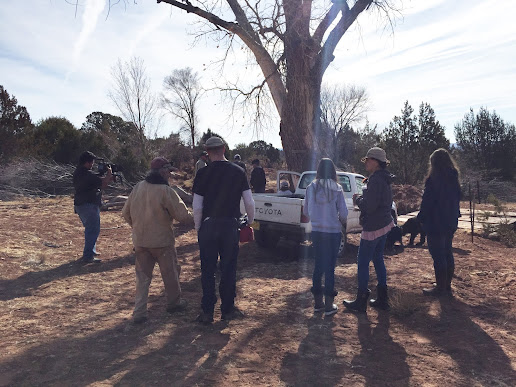The Swan Song of a Young Elder
I walked into the field ready for harvest and the red winged black birds were there, chomping on my Chihuahua blue corn. For the past two weeks, I had yelled at the happy fellows for pissing me off by eating the fruits of my labor, and was ready to again. But instead of a scream, my heart opened to a sense of gratitude for the ability to feed wildlife.
I worked a two-acre field pretty much alone last summer, growing blue corn, Bolita beans and winter squash, waiting for volunteers to come farm in community, like our ancestors have done. I spent several days with a young Hopi man who shared songs, stories, and wisdom from his elders, like “tend your corn every day as if they are your children”. I seeded by hand with a couple friends following me to close the furrows, laid four-and-a-half miles of drip lines, and was able to get germination before the irrigation ditch went dry.
Hail, monsoon rains, and winds knocked over the corn several times. Hilling the fallen stalks, weeding, and the heat wore me out. I took long naps in between hoeing sessions. All other farm work was put on hold and I went into “management mode,” as one of my elders recommended.
A handful of friends came to weed, but I harvested, husked the corn and winnowed the beans pretty much alone for ten weeks, yielding 1,500 pounds of corn, five hundred pound of squash and four hundred of beans. After six years of primarily large-scale urban farming and four years on this farm, last summer was a brutal initiation. I felt a great sense of accomplishment, but also was exhausted. Not having young people learning by my side brought me great sadness.
I started this nonprofit farm along the Pecos River, ninety miles from Santa Fe, New Mexico, after running a popular two-acre urban farm in the city. I built a campground. I became commissioner of the irrigation association managing our thirteen-mile long ditch, wrote grants to teach kids the culture of the Acequia-the communal care of the irrigation ditch. Several essays I wrote on the topic of repopulating farmland were published in well-read regional papers.
I spent the winter alone, making gallons of soups with the crops I grew, and resumed construction on a farm building I established when I moved here. I repeatedly invited my previous urban farm audience to come participate in the simple chores of a farmstead and explore the potential of this farm as a community-building center. A resident made ice cream and cacao brownies for visitors. But to my great dismay, hardly anybody came. Instead, people cheered me up on Facebook. I oddly felt like the lone star of a survivor-type reality show!
In March 2022, I turned 64, and had to admit that my strategy—“if you build it, they will come”—had failed. Continuously waiting for people to participate in a community endeavor didn’t make sense.
So it is with sadness and a sense of relief that I am putting the property up for sale. I am pleased with what I have accomplished and learned while stewarding this beautiful piece of land. The trees, berry bushes, and cover crops I planted, and the food I grew, fed a lot of wildlife. I gave myself wholeheartedly to both the project and the local community. I have no regrets.
The nonprofit was created as a community land trust, with a mission of exploring the creation of a permanent agrarian settlement, one of the principle tenets of Permaculture. Most people idealize a back-to-the-land lifestyle but don’t seem to understand that affordable farmland isn’t located at the edge of a city, and that practice tending the commons and growing a surplus of food, another tenet of Permaculture, is necessary. All of this takes great effort, resources, courage, discipline, commitment, and ingenuity. If it was easy, there would be plenty of flourishing agrarian communities in the countryside.
I lost ten pounds during the summer, but since I ate almost all the ice cream and brownies we had made for visitors, I am back to my normal weight and ready for my next adventures as a young elder. My wish is that the next owner of this farm benefits from all the work I did, and finds a way to preserve agricultural land for future generations. I believe we must create new communal settlements, where farmland is cared for, food grown, children raised, and people cared for through sickness and death.
This essay was published in the 2023 The New Farmer’s Almanac, Volume V
________________________



























